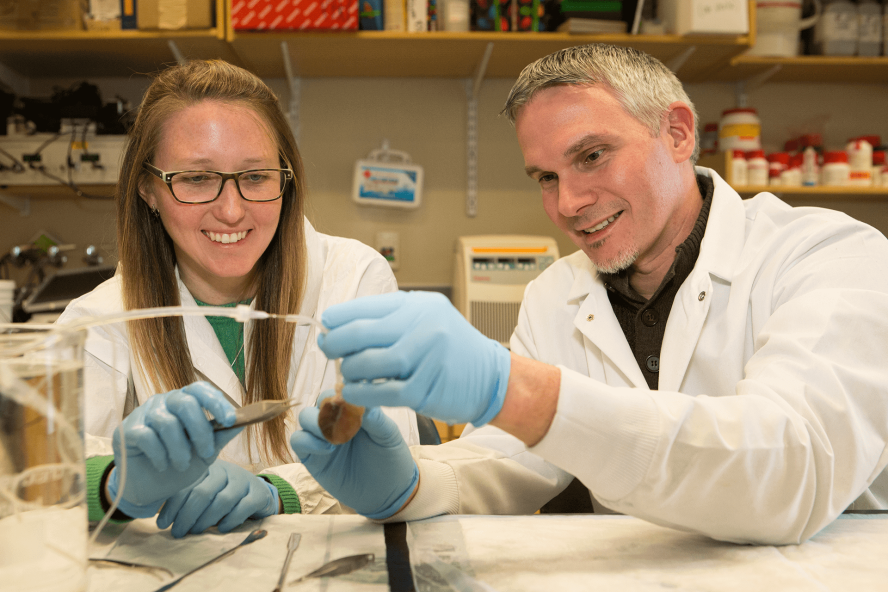Patching up broken hearts

By Lynne Powers
Collaborators from all three of Tufts University’s campuses are working together to develop a novel heart tissue graft that has the potential to grow as a patient’s heart grows. Led by principal investigator Lauren Black and funded by the U.S. Department of Defense through the Peer Reviewed Medical Research Program (Award #W81XWH-16-1-0304), the research could have a profound impact on the long-term treatment and repair of congenital heart defects in children.
Heart defects in children can lead to frightening, and potentially fatal, outcomes like loss of consciousness, turning blue, and struggling to breathe. Most of these defects are treatable by surgical interventions, and the most serious require a number of surgeries throughout early childhood.
“For the most severe defects, those surgical procedures are really designed to keep patients alive as long as possible to allow them to eventually get a heart transplant,” explains Black, an associate professor in the Department of Biomedical Engineering. “For most of them, that transplant has to happen by their mid-to-late teens or early twenties at the latest.”
Tetralogy of Fallot is a particularly complex congenital heart condition. Its defects include a narrowing of the exit from the right ventricle in the heart, a hole between the two ventricles, and enlargement of the right ventricle. The exact cause is unknown, but its impacts on children and their families are all too clear. Symptoms like heart murmurs and arrhythmias can continue for years and, if left untreated, can be fatal.
For congenital heart defects like Tetralogy of Fallot, the course of treatment is open-heart surgery to increase the size of the pulmonary valve and pulmonary arteries and to repair the hole in the wall separating the two lower chambers of the heart, allowing blood to flow more easily. As part of the initial childhood surgery, doctors often implant a patch to widen the pulmonary artery.
However, the current patches in use are made of plastic or collagen sponge. These patches don’t stretch like native heart tissue and can’t grow with the child, which means that in many cases, surgeons may have to operate again several years later to implant a new, wider patch. This process of multiple procedures could continue until the child’s heart has grown to its full size. Even with all the advances of modern medicine, it’s not without its risks — each procedure increases the patient’s risk of complications, infection, and death.
The other major problem with the plastic or collagen sponge patches is that they are unable to transmit important electrical signals the way that cardiac tissue does, which can lead to the generation of arrhythmias and other electrical abnormalities. But Black and his collaborators have proposed a new living tissue patch, utilizing a unique hybrid biomaterial, that could change everything.
Black focuses on tissue engineering and regenerative medicine-based strategies for cardiac repair. He’s spent the last several years in particular studying the cardiac extracellular matrix (ECM), an architectural network of proteins which both give structure to and signal to the cells within cardiac tissue. Currently, an injectable form of cardiac ECM derived from the porcine left ventricle is undergoing Phase I clinical trials.
“The beauty of injecting the cardiac extracellular matrix is that you get all the signaling associated with those proteins,” says Black. “But [researchers] can’t really control the structure of the gel after it’s injected. They can’t control the mechanical properties. And we know both of those things have a really important role in promoting tissue formation, regeneration, and development.”
Now there’s a novel proposed solution to that problem: silk.
Down the hall from the Black Lab in the Science and Technology Center, Professor David Kaplan’s lab has pioneered the study of silk-based biomaterials in regenerative medicine. From the work of Kaplan’s lab, Black knew that silk was a dynamic, programmable material that could be made in a number of different formats, from sponges to films to hydrogels. Silk, Black says, is “really tunable. We can tune the structure, we can tune the mechanics. You can make all kinds of things from the material, but it doesn’t have any normal binding sites for cells to adhere to.”
Black has been working with the Kaplan Lab to create a hybrid patch for Tetralogy of Fallot patients. In theory, the Cardiac Extracellular matrix-Silk (CarES) graft will combine the mutability of silk, in terms of mechanics and structure, with the binding sites and signaling peptides from the extracellular matrix. By bringing together the mechanical properties of silk and the cell signaling of the cardiac extracellular matrix, researchers are hopeful that the CarES patch will not only do a better job of creating cardiac tissue in vitro, but that it will also aid in allowing this tissue to grow with a young Tetralogy of Fallot patient.
It’s complex, ambitious research, spread across a number of Tufts labs working closely together. Biomedical engineers Black and Kaplan are developing the silk and cardiac extracellular matrix composite systems for the graft, while Associate Professor Emmanuel Tzanakakis of the Department of Chemical and Biological Engineering helps differentiate the induced pluripotent stem cells that are key to the research, and Dr. Robert Blanton of Tufts Medical Center and Dr. Raymond Kudej of the Cummings Veterinary Medical Center will test the graft.
If the CarES graft is successful for Tetralogy of Fallot patients, its technology could potentially have wider applications as well, like augmenting the ventricles of pediatric patients who have hypoplastic left heart syndrome, or even contributing to cardiac repair in adults undergoing a bypass procedure after a heart attack. In the meantime, the project is still in its early stages, but Black says he is hopeful that the CarES graft could reduce the financial, emotional, and physical burden on patients and their families. “These patients and their families already go through so much. If we’re successful, we’ll be able to lead to better long-term outcomes and hopefully change the course of their lives for the better.”
Department:
Biomedical Engineering